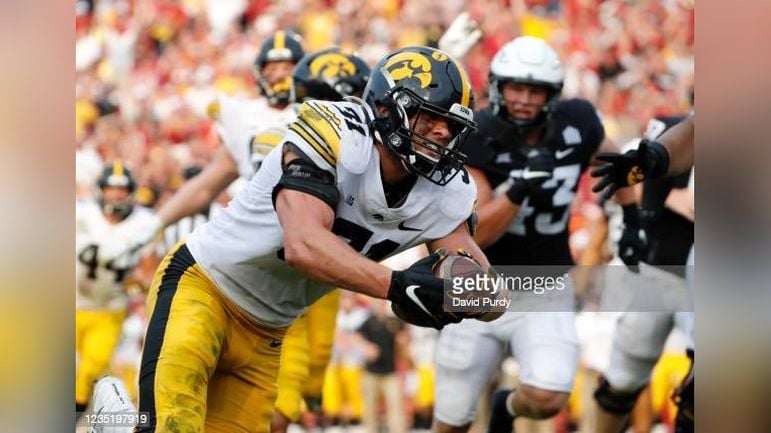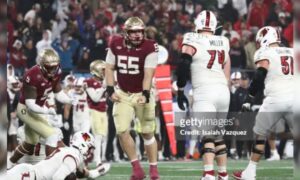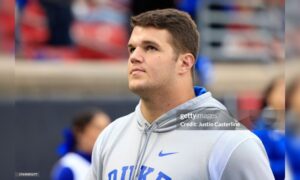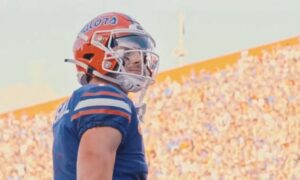I was tempted to call this article, “Confessions Of An ILB Junkie.” It wouldn’t be wrong, because I love looking into and talking about the men at the heart of a defense.
Modern football centers on mismatches, and that shows up more in the midfield defense than any other part of a team; especially since the NFL outlawed the beheading of WR’s on crossing routes (a Deebo specialty you may recall). The search for “mismatches” is almost a cliche, but it isn’t as well understood as it should be. Fans think about the defense in terms of positions, but it’s actually about roles and jobs. As you get near the line of scrimmage (“LOS”), the main jobs that need to be filled include run blitzing, pass blitzing (especially by beating RB’s mano a mano), stuffing evil-minded blockers in the hole, shutting downswing/outlet passes, and finishing off disrupted plays. Move out toward the back of the box and you need players who can cover TE’s, smother RBs that line in a WR spot, hold up against slot WRs for at least a while, and act as the final screen to prevent successful runs from turning into RB triumphs. In between those two you need someone who can do a little of everything because many situations require three bodies to handle all the midfield threats.
Those duties are traditionally handled by some combination of a Buck ILB near the LOS, a Box/Strong Safety furthest away, and a Mack ILB in the middle. But that isn’t the only way to do it. This is where sub-packages come into play; the eternally fascinating jab and counter between offense and defense to see who can gain an edge there in the middle of the field.
If that seems unduly complicated, blame it on Peyton Manning, Tom Brady, and the rest of their ilk. Those field general QB’s changed offensive play reading even a shifting defense, and then calling out audibles to exploit whatever task the defense would have the most trouble doing. They even made an art form of hurry-up offenses that let them continually pound that weakness without giving opponents a chance to rotate in a different package. QBs like that made (and make) you wrong regardless of the scheme or play call. Maddening. Even now, no defense can actually stop that kind of attack unless the pass rush can constantly get home. Sub packages are the closest thing to a counter because they allow the defense to at least choose which roles it will emphasize over others it will be weak at. But wait, there’s more! There are wrinkles that come from QBs who can run, QBs who buy extra time with escapability, QBs who… You get the idea.
Let’s get back to the point.
Think about all those roles/jobs for a moment, and you’ll quickly see why everyone is so desperate to find a truly great Mack ILB – the man in the middle. It’s the cheat code that ties everything together. With a great Mack on the field, you don’t need as many sub-packages because he can cover multiple roles all by himself. Indeed, great Macks almost never come off the field at all; they just shift seamlessly from run support to pass coverage, often after the snap in order to disguise the defensive plan. Recent and current greats include Ryan Shazier [sob], Fred Warner, Roquan Smith, Bobby Wagner, Matt Milano, etc. But here’s the thing from a draft perspective: The Steelers picked Shazier at 1:15, Warner went in Round 3, Roquan at 1:08 overall, Wagner in Round 2, and Milano down in Round 5. It seems to be a position that is all but impossible to scout. All the great ones are amazing athletes, but that isn’t more than a fraction of the required skills. Many superb athletes turn out to be so-so Macks. The special, and apparently unscoutable, part comes down to whether the young man eventually “gets it” above the neck, and learns to read the offensive play a second or two faster than all his peers. Many of the best Macks actually looked like nothing special for 3-5 years until everything clicked, and they turned into tackling and coverage machines.
Genius Buck ILBs can be a cheat code too, but in fewer ways, because they cover fewer roles. The great ones at his position are guys like a healthy Leighton Vander Esch (Round 1), Tremayne Edmunds (Round 1), a younger and healthier Myles Jack (Round 1), and Micah Parsons (Round 1). All Round 1 picks who were the source of great longing across Steeler Nation in their respective years.
You can get a cheat code via genius Safeties too, but that’s so subtle that it’s easier to show by example than to explain. Troy Polamalu. Derwin James. Jamal Adams. They amount to an extra half-player on the field at all times, which forces even the Joe Burrows of the world to double check, double clutch, and get caught every so often even when they do. Safeties like those allow a team to get by with even a barely competent Mack because they can suddenly rotate forward to double up on so many of those required jobs that were listed above. They also allow for extra and especially potent sub packages like moving in a second Buck on running plays. You can even… [Bad writer. Bad! Back to the point].
I went through all that to create a frame for what the Steelers are going to look for when they scout the off-ball Linebackers in this year’s free agency and draft classes. (1) Which roles can the player in question fill, regardless of what his position might be named? (2) How well the player does the player do those jobs? And (3), When does the player become a vulnerability that needs to rotate out for a sub-package look? All in the context of (4) the core defensive scheme, and (5) how well the rest of the defense can fill in for the jobs where this player struggles.
THE CURRENT ROSTER
- Mack/Buck ILB Myles Jack, 6’1”, 255 lbs. A genuine, 3-down, extra-large Mack ILB when he’s healthy, but just another Buck ILB once he’s dinged up. And, of course, nothing at all when he’s too hurt to play. Health is my only real complaint. Going into his 8th year, Myles Jack seems to have become one of those Ferrari types who is great until he gets to the rutted road parts of the season, at which point he needs some weeks off for the shop to handle repairs. How many games can we assume he will play? 12-14? And for how many of those will he lack the mobility needed to really handle the duties of a Mack ILB?
- Buck ILB Robert Spillane [Free Agent], 6’1”, 230 lbs. Yes, he is a step too slow and 15 lbs. too small. He’s also one step faster than others on his reads and gains about 15 lbs. from advanced technique. It evens out, but only enough to make him a solid, reliable Linebacker the coaches can always trust to be heading in the right direction. He is a free agent this year, but I think everyone expects him to return because he offers more value to this team than he would for others who might blanch at his lack of the preferred athletic profile.
- Buck ILB Mark Robinson, 5’11”, 235 lbs. The 2022 rookie sensation flashed a few times even though he is still learning the job. His superior burst and hitting power proved very useful against the run-first offenses the Steelers faced toward the end of the season, but we need to remember that he’s only been used in a very limited role. How far will his football IQ will develop over the course of his first offseason? The answer will govern how many snaps he can earn in 2023 and beyond. Hang out with Mr. Spillane young man; he does what you need to learn.
Mack ILB Devin Bush [Free Agent], 5’11”, 234 lbs.I refuse to jump on the Bush-hating bandwagon. He’s disappointed me for sure. And that hurts. When the Steelers traded up from 1:20 to 1:10, they did it in the hope that Bush could be that Genius Mack to replace Ryan Shazier. He wasn’t and he didn’t. The Devin Bush we’ve seen has been a plain, everyday Mack ILB of the sort you want to pick in Round 3, rather than the special player we hoped for. But unable to make any real contributions to his team? Far from it. The point being this: Bush’s looming departure won’t be ‘addition by subtraction,’ but should instead be seen as the loss of a middling player with great speed but little in the way of physicality or advanced instincts. No one else on the roster has that kind of speed, which will leave a hole that other teams can exploit if it doesn’t get filled.- ILB Tae Crowder, 6’1″, 235 lbs. 2020’s Mr. Irrelevant succeeded beyond all expectations by making the NY Giants roster. He played in several games over the next two years, but eventually settled into a backup role, and then got cut in 2022. The Steelers picked him up at the very end of December. More of a Buck than a Mack, and definitely more of a packages/depth piece than someone who should see the field on a regular basis.
Plus a few others who might be able to help:
- LB Malik Reed, 6’2″, 235 lbs. [Pure speculation] An undersized pass rusher who won’t make the team in that role. But he looks more like a solid Buck ILB with pass rush upside. Can he make the conversion? Probably not.
- SS Terrell Edmunds [Free Agent], 6’1”, 217 lbs. He’s big, fast, athletic, and savvy enough to cover for shortcomings at the Mack ILB position, but only to an extent. Losing both him and Bush would hit the midfield defense with a double whammy.
That’s the current roster. So what are the roles where Pittsburgh is strong, and the ones that will be weak once Devin Bush departs?
Between them, Myles Jack and Robert Spillane (and maybe Robinson) can cover all the LOS-support, Buck ILB jobs. But do they do it capital-letter Well? Probably not. And the only one who can expand beyond those limited roles would be the oft-injured Jack. It doesn’t create an actual hole, but it is a spot that could be upgraded.
The all-around, Mack ILB roles are a different story. No one but Myles Jack will have the right stuff to handle both the sideline-to-sideline run support tasks, the coverage duties against TEs and RBs; and it’s hard to see him having the health to do those jobs for more than half a season. Ferrari, rutted roads, etc. Resigning Edmunds would help, but only so much. He’s a big Safety with ILB-ish skills, but asking for more than spot duty would push the edge of his ability. Damontae Kazee can help from the back end too, but he is another free agent, even less ILB-ish, and has a fragility problem even worse than Myles Jack’s. He plays bigger than he is, but he pays for it. All of this adds up to an actual hole on the roster that must be filled or the team won’t be able to field a complete defensive roster.
It really is that bad, which tells me one thing for sure: The Pittsburgh Steelers will not go into the NFL draft without filling that hole. I won’t try to predict who they’ll get, but the Steelers are going to find a competent Mack ILB in free agency even if they have to overpay. Lock it in. It’s even possible that Devin Bush will come back like Edmunds did last year, on a one-year deal after free agency didn’t provide what he wanted. I hope not for everyone involved, but it really could happen.
So we pencil in a competent but not good Mack ILB, and then… what? In that situation, the Mack ILB position would be a slight priority for purposes of the draft. The sort of thing where someone who plays this position would win a tiebreaker if the BPA value is roughly the same. [NOTE: the situation would be much, much worse if Pittsburgh loses both Edmunds and Kazee, because that 3-Safety look would be our best way to cover up for a weaker Mack].
ROUND 1-5 DRAFT PROSPECTS FOR 2023
It isn’t a strong year for ILB talent. I wish I could say otherwise. There isn’t even a single one of those Top 10 marvels to push down some talent at another position. The only upside is that the remaining prospects seem to cluster right near where the Steelers pick in Rounds 2 and 3, so there may be a BPA competitor at ILB unless other teams are willing to reach because of their rarity.
Important Reminder: These are “Highest Value to the Steelers” grades, not forecasts of where a prospect is likely to go in the draft. That results in some minor grade inflation for positions like ILB (especially Mack ILB) that would be relatively easy to upgrade. For example, a player who should’ get picked toward the late 3rd might show up here with a grade set at 3:12 or even 3:01, because that is the spot where picking him wouldn’t be an obvious reach. It could even be 2:24 if the prospect has some assets that would fit the team particularly well. Ties get decided in favor of a higher grade. All grades remain (very) subject to change as we learn more through the process.
| 1:20 | ILB Trenton Simpson, Clemson (Senior). 6’3”, 235 lbs. with ___” arms and ___” hands. Will be a 22-year-old rookie. Just as long as he is tall, Simpson was a hybrid player in college, taking snaps from Edge on out to Strong Safety, but would be a sideline to sideline, cover-capable Mack ILB in Pittsburgh. He is the clear #1 of the class on basically every board toward what Pittsburgh wants. A tough kid with an ideal build, Simpson has the discipline of someone who comes from a military family. The downside? He hasn’t played ILB with the single-minded focus needed to really learn its intricacies, and may take several years to “get it.” A late 1st bargain if he ever does, and a pretty safe Round 2 pick if he only develops an average understanding of the NFL game. My personal shorthand has evolved into “an ILB-ish equivalent to SS Terrell Edmunds in 2018;” both for the lack of depth in his current football IQ, and as a versatile, intelligent, SPARQ’y athletic talent who fits the profile of what Mike Tomlin prefers. Jonathan Heitritter’s gif-supported Depot scouting report describes him as a tremendously versatile puzzle piece with all the tools to be a fine Mack, including the ability to set an edge when playing as an OLB. He ends with a fringe-1st grade and a comparison to a larger version of the Browns JOK. This January scouting profile is one of several that admires his explosion and burst, but believes “Simpson lacks the ability to drop weight and anchor against the run, getting manhandled at the point of attack.” The relatively thorough TDN scouting profile agrees that he has been a super versatile, almost positionless player with “Electric range, [] explosive hitting power, [impressive finishing ability, and [rare] passing-down value for a player of his stature.” The worry being his “reduced impact in 2022 when moved into a more traditional stack role” that would require him to read and get off blocks. |
| 2:01 | ILB/EDGE Drew Sanders, Arkansas via Alabama (Junior). 6’5”, 232 lbs. with ___” arms and ___” hands. Will be a 22-year-old rookie. An undersized Edge at Alabama who morphed into a successful ILB at Arkansas, his combination of athleticism, measurables, and blitzing make him the highest-ceiling Buck ILB in the draft, but the fan base that gets him should be prepared to exercise real patience as he limps through an extended learning curve. He’s flashed all the physical talent you could want but is still a newbie to the position with a double-steep learning mountain to climb. The motor is fantastic, and he has that sudden burst you look for. Also a good, violent tackler with the rare knack of knocking the runner D.O.W.N. to prevent any squirming, fall-forward yardage. The coverage skills are barely acceptable, if that, but his combination of pure athletic talent and exceptional length suggest that he ought to end up being competent in a shallow zone and could theoretically carry a TE up the seam. Gets off blocks relatively well due to his background at Edge, but does not read plays well enough to reliably hit the proper hole. |
| 2:24 | ILB Noah Sewell, Oregon (Senior). 6’2”, 253 lbs. with ___” arms and ___” hands. Turns 21 a few days before the draft. A tremendous athlete and brutal force in the traditional, thumper role now occupied by Spillane and Robinson. Athletic enough to avoid being a true liability in coverage against college athletes and offenses, but he’s going to be a two-down player in the NFL unless he can achieve a Spillane-level football IQ. Comes from an amazingly athletic family with two brothers who are also in the NFL. Samoan background. |
| 2:24 | Mack ILB Henry To’o To’o, Alabama (Senior). 6’2”, 228 lbs. with ___” arms and ___” hands. Turned 22 in January. A modern-day coverage ILB who likes to hit and is tough for linemen to catch, but lacks the size to be a genuine thumper even though he views run stuffing as job #1. Had a 2021 reputation for being slow or guessing on his reads. We will need careful scouting reports to judge how far he progressed in 2022. Has always had trouble getting off blocks, which would really annoy a traumatized Pittsburgh fan base. |
| 3.12 | DeMarvion Overshown, Texas (Senior). 6’4”, 224 lbs. with ___” arms and ___” hands. Turns 23 in August. A former Safety who outgrew the position, but is still better on the coverage side than he is in the downhill tackling role. Has the speed to be a sideline-to-sideline tackler, and the attitude, but the actual strength needs to grow. Still learning the position, which can make him a step slow. Gets a slight bump because of all that unrealized potential. |
| 3:12 | ILB Jack Campbell, Iowa (Senior). 6’5”, 246 lbs. with ___” arms and ___” hands. Turns 23 in August. An enforcer in the middle who has everything but miracle athleticism. His length will help in shallow zone coverage, but shouldn’t be asked to carry receivers downfield. Our own Chandler Stroud describes Campbell as a “weighty, hardnosed, run-thumping [ILB] just has a nose for the football,” and compares him physically to a late-career Brian Urlacher when the juice had faded. Not counting the veteran skill and savvy of course. Supposed to be a high-character part of the locker room too. |
| 3:12 | Mack ILB Owen Pappoe, Auburn (Senior). 6’1”, 225 lbs. with ___” arms and ___” hands. Will turn 23 as a rookie. A two-year team captain and on-field QB, his speed, coverage skills, overall athleticism (a 5-star coming out of H.S.), and football IQ are all excellent. But he’s never learned to get off OL blocks, may simply lack the strength to get that done, and projects as someone who will live or die according to the ability of his DL to keep him clean. One might compare him to the player Devin Bush turned out to be, rather than what Bush was drafted to be. |
| 4:01 | ILB Mohamoud Diabate, Utah by way of Florida (Senior). 6’3”, 221 lbs. with ___” arms and ___” hands. Turns 22 right after the draft. A sideline to sideline run-and-chase ILB with the athleticism to cover but only so-so coverage skills. Tackles extremely well due to playing as an undersized DE for his first few years. Understands how to get off blocks and isn’t afraid of the contact, but isn’t particularly good at it, and has a skinny frame that doesn’t promise any extra mass. This brief scouting profile ends in a Round 5 grade. |
| 4:01 | LB Ivan Pace Jr., Cincinnati (Senior). 6’0”, 239 lbs. with ___” arms and ___” hands. Will be 22 as a rookie. An undersized cannonball who is decent in coverage and affirmatively good as a blitzer. The measurables are what kill his stock. On film, he seems to lack both the size and length needed to get off NFL blocks, avoid the fate of ILBs with a small tackling radius, or succeed in coverage against a big TE. Could grow into a Vince Williams goon if he can pack on strength in an NFL training room. |
| 4:16 | ILB Daiyan Henley, Wash. St. (Senior). 6’2”, 232 lbs. with ___” arms and ___” hands. Will turn 24 as a rookie. A WR turned ILB? Yep. Henley is a physical specimen with all the below-neck assets you want for his position but held back by a serious need to learn the position. |
| 5:16 | Buck ILB Nick Herbig, Wisconsin (Junior). 6’2”, 228 lbs. with ___” arms and ___” hands. Turned 24 in January. Younger brother of Jets OG Nate Herbig. An edge-rushing OLB in college who will need to move inside to the Buck ILB spot for the NFL. 228 lbs. is just too small to be viable. But oddly, he has a fairly high floor because he is a football player to the core with a hot motor, and thus projects as a core special teamer no matter what. |
| 5:16 | ILB Dorian Williams, Tulane (Senior). 6’2”, 225 lbs. with ___” arms and ___” hands. Will turn 22 in June. A competent 4-3 Mike (middle) LB and team leader in college, who is supposed to fall short for NFL purposes on both the speed and strength fronts. Projects as a good, core special teamer who could grow into backup ILB duties after a year or two of work with a good NFL conditioning coach. |
NOTE: For those who didn’t know it, Ohio State’s Tommy Eichenberg has returned to school for the 2023 season.
BONUS ENTRIES
The draft also has two very good but very undersized Edge Rushers, who might do better in the pros if they made the jump to Buck ILB. Neither has ever done it before so this is pure speculation.
| 2:12 | EDGE/ILB Nolan Smith, LSU (Junior). 6’2”, 235 lbs. with ___” arms and ___” hands. Will be a 21-year-old rookie. NOTE: deserves a 1:20 grade on an all-teams board. Discounted here for lack of size. A brilliant athlete who plays as an Edge but has a Buck ILB physique. The leader of men for CFB’s best 2023 defense, who injects emotion, violence, and physicality into the scheme. In the ideal (Pittsburgh) world he would be a Micah Parsons type, a/k/a Vince Williams with a 5-star athletic profile and major pass rush skills. Sounds great, but he’s never been asked to play that role. As a pure pass rusher for the Pittsburgh defense…? The size just isn’t there, and it shows. |
| 3:12 | ILB/EDGE Nick Hampton, App. St. (Junior). 6’3”, 235 lbs. with ___” arms and ___” hands. Will be a 23-year-old rookie. A pass-rushing OLB in college who wins on pure twitch, burst, bend, and overall athleticism that’s simply better than his opponents. But he’s built like an ILB who is far smaller than the likes of Watt or Highsmith. Is he a hybrid or a tweener? |








